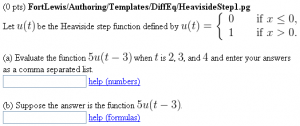Difference between revisions of "HeavisideStep1"
| Line 170: | Line 170: | ||
<p> |
<p> |
||
<b>Setup 2:</b> |
<b>Setup 2:</b> |
||
| − | Using <code>parserFunction.pl</code>, we add another function named <code>u( |
+ | Using <code>parserFunction.pl</code>, we add another function named <code>u(t)</code> to the context. The reason for adding this function to the context is that |
* <code>step</code>, which is the Heaviside function, will be used when the answer is a number, and |
* <code>step</code>, which is the Heaviside function, will be used when the answer is a number, and |
||
Revision as of 03:41, 6 December 2010
Using the Heaviside Step Function
This PG code shows how to add a the Heaviside step function step(x), which takes the value 1 if x > 0, and the value 0 if x ≤ 0, to the context. It also shows how to add a named function u(x) to the context that has a reliable answer checker and can stand in for the Heaviside step function when the student answer is a function.
- Download file: File:HeavisideStep1.txt (change the file extension from txt to pg when you save it)
- File location in NPL:
FortLewis/Authoring/Templates/DiffEq/HeavisideStep1.pg
| PG problem file | Explanation |
|---|---|
|
Problem tagging: |
|
DOCUMENT(); loadMacros( "PGstandard.pl", "MathObjects.pl", "AnswerFormatHelp.pl", "parserFunction.pl", ); TEXT(beginproblem()); |
Initialization:
We load |
$ftex = "5 u(t-3)";
Context("Numeric");
Context()->variables->are(t=>"Real");
Context()->functions->add(
step => {
class => 'Parser::Legacy::Numeric',
perl => 'Parser::Legacy::Numeric::do_step'
},
);
$f = Formula("5*step(t-3)");
$answer1 = List($f->eval(t=>2),$f->eval(t=>3),$f->eval(t=>4));
|
Setup 1:
We add the step function to the context with the name
We will not use the function |
Context()->texStrings;
BEGIN_TEXT
Let \( u(t) \) be the Heaviside step function
defined by
\( \displaystyle
u(t) =
\left\lbrace
\begin{array}{lcl}
0 && \mbox{ if } x > 0, \\
1 && \mbox{ if } x \leq 0.
\end{array}
\right.
\)
$BR
$BR
(a) Evaluate the function \( $ftex \) when
\( t \) is 2, 3, and 4 and enter your answer
as a comma separated list.
$BR
\{ ans_rule(20) \}
\{ AnswerFormatHelp("numbers") \}
END_TEXT
Context()->normalStrings;
|
Main Text 1: |
$showPartialCorrectAnswers=1; ANS( $answer1->cmp(ordered=>1) ); |
Answer Evaluation 1: |
Context("Numeric");
Context()->variables->are(t=>"Real");
Context()->flags->set(
limits=>[-5,5],
num_points=>10,
);
parserFunction("u(t)" => "1.5*sin(e*t)+5*pi/e+arctan(t)");
$answer2 = Formula("5 u(t-3)");
|
Setup 2:
Using
Notice that the function
Note: Currently, functions that are added to the context do not work with |
Context()->texStrings;
BEGIN_TEXT
$BR
$BR
(b) Enter the function \( $ftex \).
$BR
\{ ans_rule(20) \}
\{ AnswerFormatHelp("formulas") \}
END_TEXT
Context()->normalStrings;
|
Main Text 2: |
ANS( $answer2->cmp() ); |
Answer Evaluation 2: |
Context()->texStrings;
BEGIN_SOLUTION
${PAR}SOLUTION:${PAR}
Solution explanation goes here.
END_SOLUTION
Context()->normalStrings;
COMMENT('MathObject version.');
ENDDOCUMENT();
|
Solution: |
